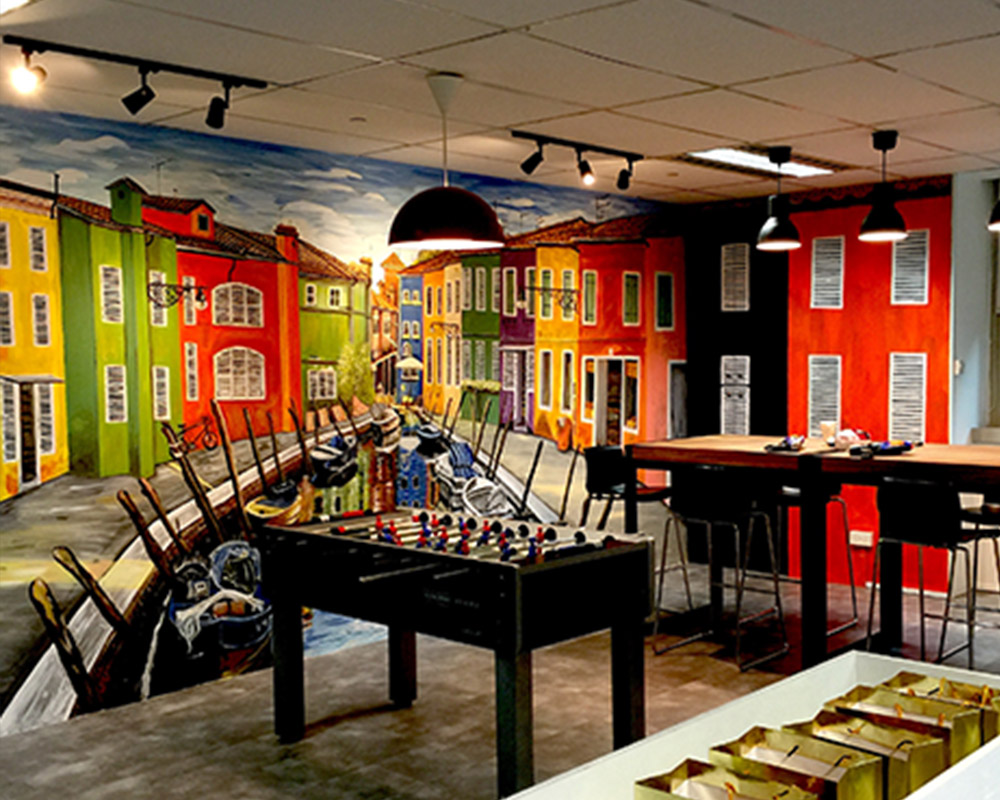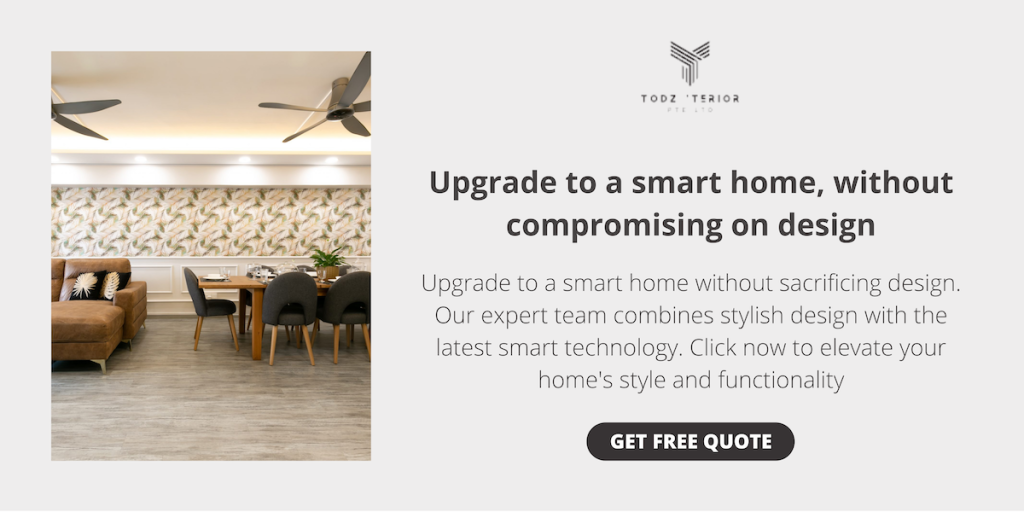Smart technology is revolutionizing the way we live and work, and it’s no different in commercial interior design. In Singapore, the use of smart technology in commercial spaces is on the rise, as businesses look for ways to improve efficiency, productivity, and the overall user experience. From intelligent lighting and climate control systems to smart locks and security systems, there are countless opportunities to incorporate smart technology into your commercial interior design. However, with these opportunities come risks, including cybersecurity threats and the potential for technology to become a distraction.
In This Article
ToggleIn this article, we’ll explore the opportunities and risks of using smart technology in commercial interior design in Singapore, and provide tips for making smart technology work for you.

Opportunities of smart technology in commercial interior design
Smart technology is revolutionizing the commercial interior design industry by providing new opportunities for improved energy efficiency, enhanced user experience, and increased productivity.
Here are some key opportunities of smart technology in commercial interior design:
1) Improved energy efficiency and sustainability
Smart technology can help reduce energy consumption and promote sustainability by optimizing the use of lighting, heating, and cooling systems. For example, smart lighting systems can automatically adjust the brightness and color temperature of the lights based on the time of day and occupancy of the space, which can help reduce energy waste and lower utility bills.
2) Enhanced user experience and convenience
Smart technology can also enhance the user experience and convenience of a commercial space by providing features such as automated controls for lighting, temperature, and audiovisual systems. For example, a smart conference room could have a system that automatically adjusts the lighting and temperature based on the number of people in the room, making it easier for users to focus on the meeting.
3) Increased productivity and efficiency
Smart technology can also increase productivity and efficiency in a commercial space by providing features such as occupancy sensors that can automatically turn on the lights and activate the HVAC system when a person enters the room. This can help reduce the time it takes for occupants to set up the space, allowing them to focus on their work.
Risks of smart technology in commercial interior design
While smart technology offers many benefits in commercial interior design, there are also some risks and challenges that designers should be aware of. Here are some of the key risks of smart technology in commercial interior design:
1) Data privacy and security concerns
Smart technology often involves collecting and transmitting data, which can create privacy and security risks if not properly secured. Designers need to ensure that the systems they use comply with relevant data protection regulations and that appropriate security measures are in place to protect the data from cyber-attacks and unauthorized access.
2) Technical malfunctions and system failures
Smart technology relies on complex systems and software, which can be prone to malfunctions and failures. These issues can cause disruptions and downtime, which can be costly for businesses. Designers need to ensure that the systems they use are reliable and that backup systems are in place in case of technical issues.
3) Cost and maintenance issues
Smart technology can be expensive to install and maintain, which can be a barrier to adoption for some businesses. Designers need to consider the total cost of ownership when selecting smart technology solutions and ensure that maintenance and support agreements are in place to minimize downtime and ensure the longevity of the system.

Implementation of smart technology in commercial interior design in Singapore
Singapore is known for its commitment to innovation and sustainability, and this is reflected in the implementation of smart technology in commercial interior design. Here are some examples of smart technology in commercial spaces in Singapore:
- Marina Bay Sands: This iconic integrated resort features an extensive use of smart technology in its design, including a Building Management System that monitors and controls the lighting, air conditioning, and other systems throughout the complex.
- Microsoft Singapore: The Microsoft office in Singapore features a range of smart technology solutions, including a smart lighting system that automatically adjusts the lighting based on occupancy and daylight levels, and a Building Management System that optimizes energy use and monitors the building’s environmental performance.
- PwC Singapore: The PwC office in Singapore features a range of smart technology solutions, including a smart lighting system that can be controlled through a mobile app, and a Building Management System that optimizes energy use and improves occupant comfort.
Successful implementation strategies for smart technology in commercial interior design in Singapore include:
- Conducting a thorough analysis of the building’s energy use and identifying areas for improvement
- Engaging with stakeholders and end-users to understand their needs and preferences
- Selecting smart technology solutions that are compatible with existing systems and can be integrated easily
- Providing training and support to end-users to ensure they are comfortable with the new systems
Some of the challenges of implementing smart technology in commercial interior design in Singapore include:
- High upfront costs for installation and maintenance
- Data privacy and security concerns
- Technical issues and system failures
Despite these challenges, the benefits of smart technology in commercial interior design are significant, and many businesses in Singapore are embracing these solutions to improve their sustainability, productivity, and user experience.
Regulations and standards for smart technology in commercial interior design in Singapore
Smart technology in commercial interior design is subject to regulations and standards in Singapore to ensure that the systems are safe, reliable, and compliant with relevant regulations.
Here are some of the key regulations and standards that apply to smart technology in commercial interior design in Singapore:
- Building Control Act: This act governs the construction and maintenance of buildings in Singapore and includes regulations related to electrical installations and fire safety, which are relevant to the installation of smart technology systems.
- Code of Practice for Building Control: This code provides guidance on the design, construction, and maintenance of buildings in Singapore and includes standards related to energy efficiency, indoor environmental quality, and other factors that are relevant to smart technology in commercial interior design.
- Green Mark Certification: This certification scheme is administered by the Building and Construction Authority (BCA) and provides recognition for buildings that are designed and operated in an environmentally sustainable manner. Smart technology solutions can contribute to the achievement of Green Mark Certification.
- Singapore Standard for Intelligent Building Systems: This standard provides guidance on the design and implementation of intelligent building systems, including smart technology solutions for commercial interior design.
The Singapore government plays a key role in regulating and promoting smart technology in commercial interior design through agencies such as the BCA and the Infocomm Media Development Authority (IMDA). Industry organizations such as the Singapore Green Building Council and the Association of Property and Facility Managers also play a role in promoting best practices and standards for smart technology in commercial interior design.

Future outlook for smart technology in commercial interior design in Singapore
As technology continues to advance rapidly, the future outlook for smart technology in commercial interior design in Singapore is promising. Here are some emerging trends and innovations that are expected to shape the future of smart technology in commercial interior design:
- Internet of Things (IoT) technology: IoT technology enables devices to communicate with each other and collect and share data, allowing for more advanced and interconnected smart technology systems.
- Artificial Intelligence (AI) and Machine Learning (ML): AI and ML can be used to analyze data from smart technology systems and optimize building performance in real-time.
- Augmented Reality (AR) and Virtual Reality (VR): AR and VR can be used to simulate and visualize building design and performance, allowing designers and stakeholders to make informed decisions about smart technology solutions.
- Wearable technology: Wearable technology such as smart watches and fitness trackers can be integrated with smart technology systems to provide personalized and responsive user experiences.
The potential benefits of smart technology in commercial interior design are numerous, including:
- Improved energy efficiency and sustainability
- Enhanced user experience and comfort
- Increased productivity and efficiency
- Reduced maintenance and operating costs
However, there are also potential risks associated with smart technology in commercial interior design, including:
- Data privacy and security concerns
- Technical malfunctions and system failures
- High upfront costs for installation and maintenance
What we have learnt
As Singapore continues to embrace smart technology, commercial interior design has the potential to be transformed. While there are certainly many benefits to incorporating smart technology into commercial spaces, there are also risks that must be considered. By staying informed and making thoughtful decisions, businesses can make the most of the opportunities that smart technology presents while minimizing the risks. As the industry continues to evolve, it will be important for businesses to stay up to date on the latest trends and best practices to create spaces that are both technologically advanced and safe for all who use them.
Renovate with Todzterior!
We’re here to help you get started with Smart Home solutions.
Todzterior is the only company whose mission is to make homes “Smart.” In other words, our Smart Home solutions are built to help make your life easier. The possibilities for the future of the smart home are endless. You’ve come to the right place. We’re here to help you get started with Smart Home solutions and ensure you with smart quality and reliability.
Don’t hesitate to find out more about us. Call us here or visit our showroom at 7 Gambas Crescent #01-03 Ark@Gambas Singapore 757087.
Frequently asked Question
1) What is smart technology in commercial interior design?
A: Smart technology refers to the integration of electronic devices and systems with commercial interior design to create a more efficient, comfortable, and sustainable space.
2) What are some examples of smart technology in commercial interior design?
A: Examples include automated lighting and temperature control systems, occupancy sensors, smart locks and security systems, and digital signage.
3) What are the benefits of using smart technology in commercial interior design?
A: Smart technology can lead to increased energy efficiency, improved productivity, enhanced security, and a more seamless and personalized user experience for customers and employees.
4) What are some potential risks associated with using smart technology in commercial interior design?
A: Risks include data privacy and security concerns, technological malfunctions, and potential loss of human interaction and personalization in the space.
5) How can businesses in Singapore ensure the safe and effective use of smart technology in their commercial interior design?
A: Businesses should work with experienced professionals and carefully consider the potential risks and benefits before implementing any smart technology systems. They should also prioritize data privacy and security measures and regularly assess and update their technology systems.

